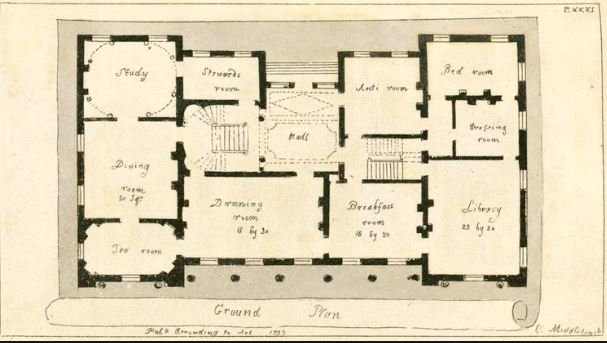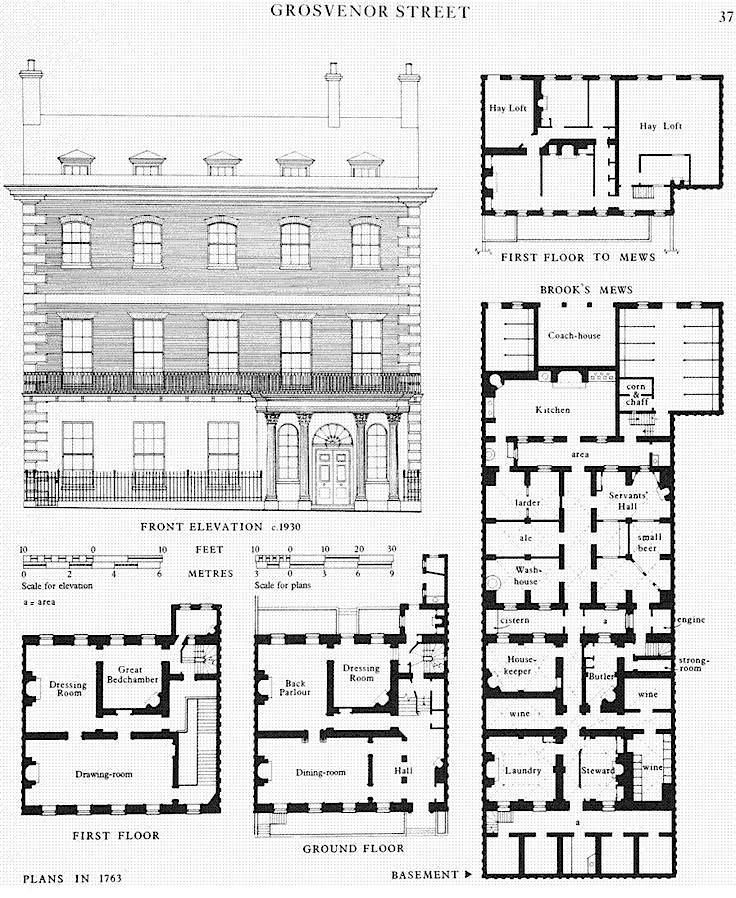
In a follow up from my post/questions about bathroom habits of Regency people, and expanding on an earlier post about cloak rooms and withdrawing rooms, on offer today is a detailed look at withdrawing or retiring rooms. Tara K wants to know:
there are myriad references of ladies going to the withdrawing room. However, the townhouse floor plans I’ve seen do not include any such withdrawing rooms. Exactly where are these rooms? Or… when one planned a ball, did the hostess set aside a bedroom or other room as the withdrawing room for the event? If it was a bedroom, wasn’t that a bit risque in the first place? Also, how did anyone know which room was the ladies’ withdrawing room? Was there always a maid or footman standing by to direct them? “This way to pee, my lady. Or were you just looking for Lord Graystone in that darkened bedroom on the second floor?…”
This is a good opportunity to talk a bit about the rooms of the average wealthy home. Most of the information below is gleaned from the excellent 1865 resource The Gentleman’s House: Or, How to Plan English Residences, from the Parsonage to the Palace …
First things first, what the British call the ground floor is what Yanks call the first floor. So Americans, the first floor is actually what you would consider the second floor. Therefore on the plans when you see ground floor or ground plan, think about it as the main floor or the one with entrance from the street/ground.
 Basements, generally, held the “guts” of the house (both manor and townhouses). This is where many of the servant quarters, kitchens, pantry, laundry, and other “working” rooms would be. Makes it deuced inconvenient for piping hot food on the dinner table, but a good way to segregate the staff from the family. Depending on the house, you may also have some servants quarters in the attic, but these were typically reserved for those occupying the purgatory between staff and family like the governess.
Basements, generally, held the “guts” of the house (both manor and townhouses). This is where many of the servant quarters, kitchens, pantry, laundry, and other “working” rooms would be. Makes it deuced inconvenient for piping hot food on the dinner table, but a good way to segregate the staff from the family. Depending on the house, you may also have some servants quarters in the attic, but these were typically reserved for those occupying the purgatory between staff and family like the governess.
Ante Room (or Chamber): Typically some type of waiting room, lobby, foyer or vestibule serving as an entrance into a larger one. This might be one possible option for a designated retiring room during events, or it could be used as a cloak room.
Morning room: Living or sitting room, typically used in the first part of the day to catch the morning sun.
Breakfast Room: Often thought of as an “inferior variety of the morning-room” except that it was used more commonly as a place to eat a variety of meals when just among the family. May also be a place where children had dinner.
Dining Room: A stately room mostly used for formal meals. Dining rooms would also be places for men to congregate after dinner while women “withdrew” to the drawing room.
Library: For book storage and depending on the size may also include lounging or desk furniture. Also served as a type of morning room for gentlemen.
Study: A small library type room for quiet reading and reflection. May also be used as a place for the gentleman to conduct business, if the house did not have a Business or Gentleman room.
Saloon: Often between Library and Drawing Room, could be used as an ante room or be thrown open for parties and events. Often more of a thoroughfare type room.
Drawing Room (or Withdrawing Room): Where typically the ladies domain where they would “withdraw” after dinner while the men lingered with port and politics. Also could serve as a sitting room for the family, a place to receive calls or gather before and after dinner. Men would typically join ladies there after they were done with their man time. Also frequently used as a reception room during balls or parties. Conceivably could also be used as a retiring room during balls, depending on its location in the house.
There are a variety of other room types, so its worth a perusal of The Gentleman’s House, but you get the gist.
Until the advent of indoor plumbing a designated room for “business” was not included in plans. Because family rooms were typically not opened to the public, your right in thinking sending someone upstairs to do their business would’ve been weird. I think it more likely that a conversion of one of the ground floor rooms would’ve been commonplace. A withdrawing (or drawing) room would have been the most comfortable, but I could also see a smaller ante chamber being used for an evening.
Its not black and white because home plans varied so drastically between era of build, size, and the type of family. The Gentleman’s House, written in the Victorian era, suggests that a “roomy closet” near the entrance might serve as the lavatory provided you can fit a wash basin (and also a chamber pot). Dressing rooms, also sometimes on the ground floor were often “sufficient to accommodate…two wash basins, with enclosure under, a side-table, chairs, and perhaps a fireplace.” They go on to suggest that the proximity to the entrance hall is the most common, and therefore the most easy for visitors to find.
In the description of water closets, the book’s author seems to suggest that most cloak rooms will also have a lavatory sized closet for people to use. He continues:
So, where does that leave us gentle readers? Likely with a little closet or chamber discreetly tucked within another room on the ground floor, near the entrance. If no closets were available, a section of a withdrawing room may be designated, or an ante chamber. If chamber pots were in use, there likely was a maid or footman stationed during large gatherings to empty said pots.
My advice to authors (and even readers) is to think a bit about your floorplan, even sketch it out and plot where the most logical place for the “necessary” would be.

Good ground floor plans: The Architect and Builder’s Miscellany or Pocket Library (available digitally here: https://digitalcollections.nypl.org/collections/the-architect-and-builders-miscellany-or-pocket-library#/?tab=about)
A lovely article on the Drawing Room’s history and importance for the country house: http://www.countrylife.co.uk/articles/history-country-house-drawing-room-63348











